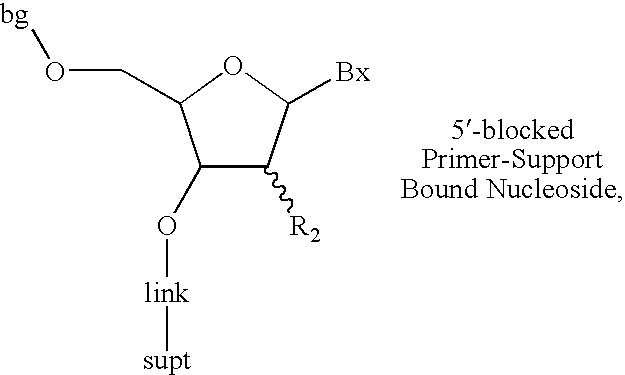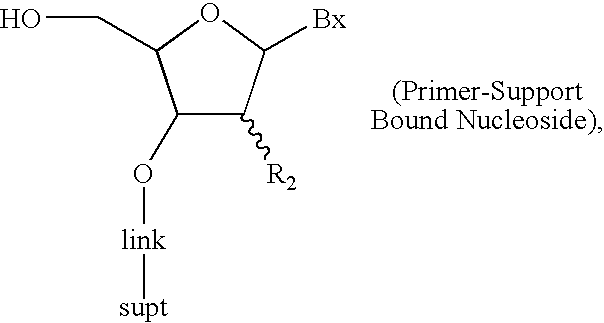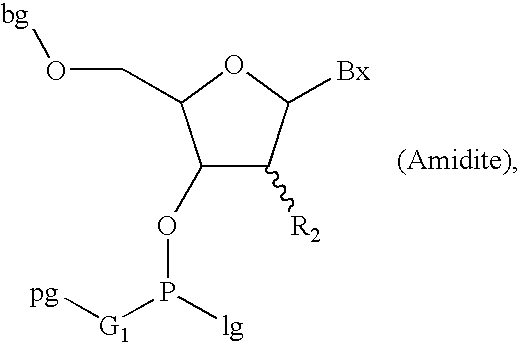Oligonucleotide synthesis with alternative solvents
a technology of oligonucleotide and solvent, applied in the field of oligomer synthesis, can solve the problems of relatively high cost of acetonitrile and inacceptable in view of high cost of raw materials such as amidites
- Summary
- Abstract
- Description
- Claims
- Application Information
AI Technical Summary
Benefits of technology
Problems solved by technology
Method used
Image
Examples
example 1
80 mmole Solid Phase Synthesis of ISIS 2302
[0522]The following phosphorothioate oligodeoxyribonucleotide was prepared according to the procedures set forth below: ISIS 2303=5′-GCC-CAA-GCT-GGC-ATC-CGT-CA-3′.
[0523]Primer support having a loading value of 90 μmol / g was obtained, and the amount of primer support necessary to obtain 80 mmol of the 3′-terminal nucleoside attached to solid support was calculated to be 888.9 g of support. Support, 889.1 g, was weighed into a polypropylene container and 400-500 mL of acetonitrile per 100 g of support were added to produce a slurry. The support was then packed into a suitable column, which was attached to the Amersham OligoProcess synthesizer per established procedures. A new synthesis result directory was created to produce the sequence set forth above.
[0524]Deblock solution, activator solution, deoxyphosphoramidite solutions, thiation solution, capping solution A, capping solution B, triethylamine solution, acetonitrile and toluene were loa...
example 2
0.75 mmole Synthesis of ISIS-3521
[0541]A procedure similar to that employed in Example 1, above, was followed for preparation of 0.75 mmole of ISIS3521: 5′-GTT-CTC-GCT-GGT-GAG-TTT-CA-3′, with modifications as noted below.[0542]The primer support was slurried and packed in toluene.[0543]The cycle for addition of each nucleotide was:[0544]Detritylation: DCA in toluene;[0545]Column wash: toluene (3 column volumes, 81 ml) followed by acetontrile (1 column volume, 27 ml);[0546]Coupling: phosphoramidite in acetonitrile;[0547]Acetonitrile push / wash;[0548]Oxidation: phenyl acetyl disulfide in acetonitrile;[0549]Toluene push (instead of usual acetonitrile push);[0550]Capping: Reagent A;[0551]Capping: Reagent B;[0552]Toluene wash (1.5 CV, ˜40.4 ml).
[0553]This cycle is repeated for each of the nucleotides to be coupled to the oligonucleotide. Synthesis completes with the final toluene wash, after which the protocol for cleaving the oligonucleotide from the support was conducted as outlined in ...
example 3
0.75 mmole Synthesis of ISIS-3521
[0557]A procedure similar to that employed in Example 2, above, was followed for preparation of 0.75 mmole of ISIS-3521: 5′-GTT-CTC-GCT-GGT-GAG-TTT-CA-3′, with modifications as noted below.[0558]The primer support was slurried and packed in toluene.[0559]The cycle for addition of each nucleotide was:[0560]Detritylation: DCA in toluene;[0561]Column wash: toluene (3 column volumes, 81 ml) followed by acetonitrile (1 column volume, 27 ml);[0562]Coupling: phosphoramidite in acetonitrile;[0563]Acetonitrile push / wash;[0564]Oxidation: phenyl acetyl disulfide in acetonitrile;[0565]Capping: Reagent A; (acetonitrile / toluene push eliminated) Capping: Reagent B;[0566]Toluene wash (1.5 CV, ˜40.4 ml).
[0567]This cycle was repeated for each of the nucleotides to be coupled to the oligonucleotide. Synthesis was completed with the final toluene wash, after which the protocol for cleaving the oligonucleotide from the support was conducted as outlined in Example 1, abov...
PUM
| Property | Measurement | Unit |
|---|---|---|
| v/v | aaaaa | aaaaa |
| v/v | aaaaa | aaaaa |
| weight | aaaaa | aaaaa |
Abstract
Description
Claims
Application Information
 Login to View More
Login to View More - R&D
- Intellectual Property
- Life Sciences
- Materials
- Tech Scout
- Unparalleled Data Quality
- Higher Quality Content
- 60% Fewer Hallucinations
Browse by: Latest US Patents, China's latest patents, Technical Efficacy Thesaurus, Application Domain, Technology Topic, Popular Technical Reports.
© 2025 PatSnap. All rights reserved.Legal|Privacy policy|Modern Slavery Act Transparency Statement|Sitemap|About US| Contact US: help@patsnap.com



